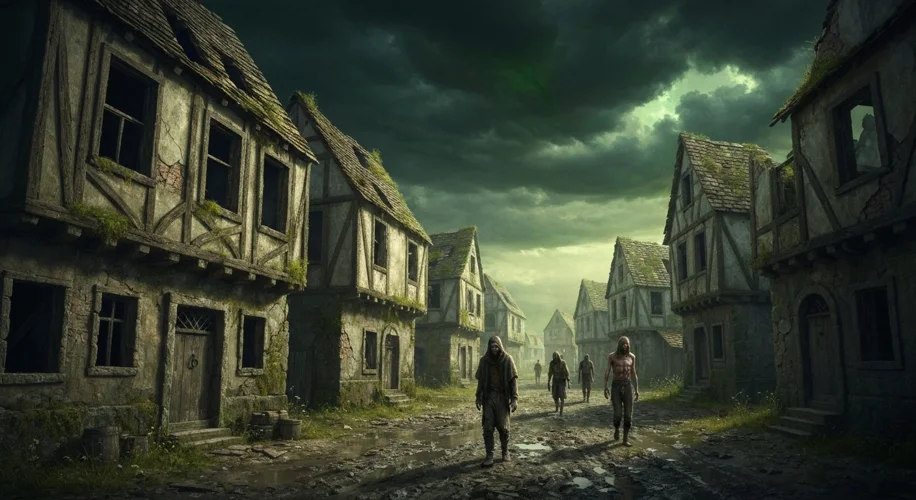In the mid-14th century, a shadow fell across Europe, a pestilence so devastating it would forever be known as the Black Death. This bubonic plague, believed to have originated in Central Asia, swept westward with horrifying speed, decimating populations and leaving a trail of fear and despair in its wake. While its grip tightened on much of the continent, a curious anomaly emerged in the vast lands of the Polish-Lithuanian Commonwealth. Unlike its ravaged neighbors, this burgeoning union seemed to possess a strange, almost defiant, resilience against the plague’s most brutal onslaughts.
But was this apparent immunity a blessing in disguise? Did this shield from the grim reaper inadvertently sow the seeds of Poland-Lithuania’s eventual unraveling? The historical record suggests a complex and perhaps even tragic interplay between disease, demographics, and destiny.
The Black Death, arriving in Europe around 1347, was a cataclysm of unimaginable proportions. Estimates vary, but it’s widely believed that between 30% and 60% of Europe’s population perished within a few short years. Cities were emptied, villages abandoned, and the very fabric of society strained to breaking point. The plague’s symptoms were horrific: swollen lymph nodes, fever, chills, and agonizing pain, often leading to death within days. The psychological impact was equally profound, fostering an atmosphere of religious fervor, apocalyptic dread, and a fatalistic acceptance of mortality.

Across Europe, the consequences were far-reaching. Labor shortages became acute, leading to the collapse of feudal systems in some areas. Wages for surviving workers soared, shifting economic power. Social unrest and peasant revolts erupted as the old order struggled to adapt. The plague also fueled witch hunts and scapegoating, as people desperately sought explanations for the inexplicable suffering.
Yet, the Polish-Lithuanian lands, particularly the Kingdom of Poland, appear to have been spared the worst. While not entirely untouched, the mortality rates were significantly lower than in, say, Italy, France, or England. Several theories attempt to explain this relative immunity. Geographic factors, such as lower population density and fewer major trade routes passing through the heartland, may have played a role. Some scholars also point to a different diet, perhaps less reliant on grain that could be contaminated, or even a different genetic makeup of the fleas and rats that carried the disease. Early public health measures, though rudimentary, might have also contributed.
This demographic preservation, however, created a peculiar historical dynamic. While other nations grappled with the immediate, desperate need to repopulate and rebuild, Poland-Lithuania found itself in a stronger position. This relative demographic stability provided a crucial advantage in the immediate aftermath of the plague. The Commonwealth could maintain its agricultural output, sustain its military strength, and continue its political development with less disruption than many of its neighbors.
But here lies the potential paradox. In a continent struggling with depopulation and economic upheaval, Poland-Lithuania’s relative strength could have fostered a sense of complacency, a belief in its own exceptionalism. This might have contributed to a less adaptable and more rigid social and political structure compared to nations forced to fundamentally re-evaluate their systems in the face of overwhelming loss.
Consider the economic implications. While other regions experienced a surge in wages for laborers due to scarcity, Poland-Lithuania, with a larger surviving workforce, may not have seen the same dramatic shifts. This could have slowed down the transition away from serfdom and maintained a more traditional, less dynamic labor market. The aristocracy, perhaps less severely impacted, might have retained more of its traditional power, potentially stifling broader social and economic reforms.
Socially, the shared trauma of the Black Death in other European countries fostered a sense of collective experience and, in some cases, led to greater social mobility as old hierarchies were disrupted. Poland-Lithuania, by contrast, might have preserved its established social strata more effectively, potentially limiting opportunities for advancement and contributing to a less dynamic society.
Furthermore, the very act of not experiencing the same level of demographic collapse might have altered Poland-Lithuania’s perspective on its neighbors. While others were focused inward on recovery and rebuilding, Poland-Lithuania may have seen its less-affected state as a sign of inherent superiority, potentially leading to more ambitious foreign policy or a less cautious approach to conflict.
The long-term consequences are debated by historians. Some argue that Poland-Lithuania’s demographic advantage allowed it to become a major European power in the centuries that followed. Its population base remained relatively intact, enabling it to raise larger armies and maintain economic stability.
However, other historical analyses suggest that the very lack of the plague’s

